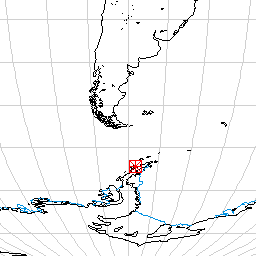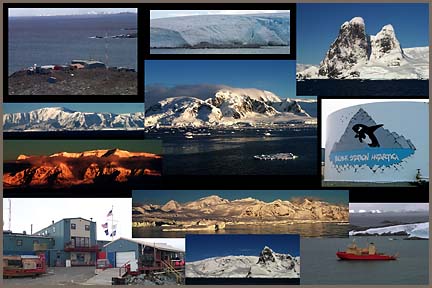 |
|
|
 |
| What a day, clear skies and light winds. We went to Palmer Station at 8:30 this morning and stayed until around noon. I really wanted to hike and there was a great walk up the glacier behind the station. It is flagged so you cannot fall in a crevase and is easy walking. The thin photo, second down on the left, is the view from the top. As we walked back I took the photo of Palmer Station. It is the one in the upper left corner. OK for the rest of the photos. Upper left palmer station, next two mountains on the Graham coast, bottom left,main building at palmer station with boat house in the foreground. Middle top glacier flowing over bedrock into the sea, next more beautiful mountains along the Graham coast, as are the two shots below. Upper right, towering granite (?) spires at the end of the Graham coast at the entrance to Flandres Bay. These are at approximately 65 S 63 50 W and are almost 800 meters tall. Below them is the big tank at Palmer obviously, and finally a view of the ship in the bay next to Palmer Station. The glacier over granite shot at the top of the middle column is a detail of the glacial tongue visible behind the ship in the bottom right hand photo. |
 |
Awoke this morning to find us anchored off Palmer Station, the US science base on the Palmer Peninsula, located around 64 50 S 64 05 W. The station is actually on Anvers Island. We went from the NB Palmer to Palmer station by Zodiac raft. Climbing down a rope/wood ladder to a bobbing Zodiac loaded with carmera equipment and dressed in bulky clothing topped off by a survival jacket was exciting. To add to the lack of grace with which most of us entered the Zodiac, the floor of the Zodiac was a sheet of ice.
Palmer looks like many of the established bases in Antarctica. Sheet metal buildings with cargo stored nearby. This particular one is on a granitic point on the island. Extensive blasting cleared a resonably flat area for the buildings. Glaciers flow down to the sea on either side of the base and small rock free islands fill the bay off shore from the station.
Most of the buildings are connected by raised walkways. It snows quite heavily here during the winter. Just off shore from the station on the small rock islands is where Adalie penguins nest. The season had passed and we did not see any penguins. When the penguins leave the nesting areas they head out to sea for the winter, living mainly on the open ocean, returning in the spring to nest.
According to Bill Frasher, penguin ecologist, the penguin population in this area is rapidly decreasing due to the warming climate. Penguins are dependent on snow free areas to build there nests and with the warming in this area the climate is shifting from a cold/dry winter to a warmer/moister climate which is resulting in more snow.
The greater snowfall does not melt in time for the nesting areas to be clear for the returning penguins to nest in their normal way and chick mortality is very high. This area seems to be very susceptible to climate change. South of Palmer in Margarite Bay is another large penguin area and this area seems to be stable for the time being.
After we left Palmer Station we headed around Anvers Island and northeast in assorted channels between the offshore islands and Graham and Danco Coasts. These coastlines are lined with spectacular mountains rising 6000'+, right up from the water. Weather was clear, sunny and not terribly cold. Just about everybody was on the bridge watching the scenery and taking photos. We had the perfect combination of scenery and clear weather. The photographer from Discover Magazine was very happy. The flat gray light for the past week has been making him very unhappy. Enroute from Palmer to our next station at Andvord Bay we passed Paradise Harbor, this is a common anchorage for Antarctic tour boats. We did not see any boats today.
Currently we are traveling slowly toward Andvord Bay. We are profiling the bottom with the multibeam, and Bathy 2000 bottom profilers and will be taking a Kasten, multi, and jumbo piston cores sometime around 2 am. If the weather holds, the scenery in Andvord Bay promises to be quite a sight.
Cheers,
Dave Tewksbury
|
|
 |